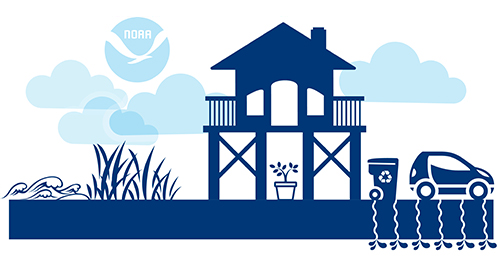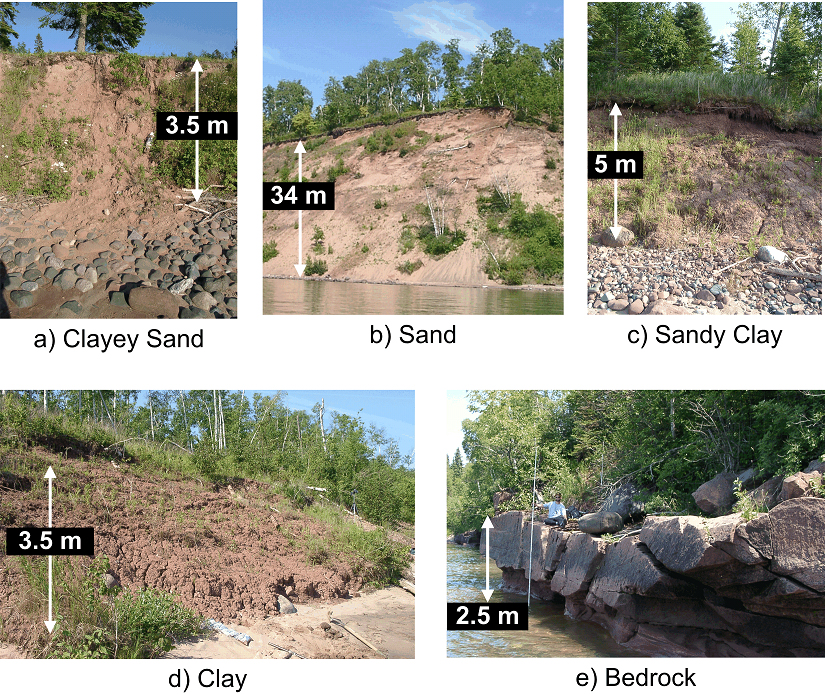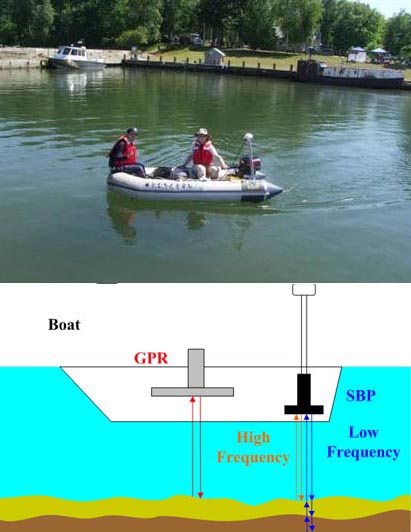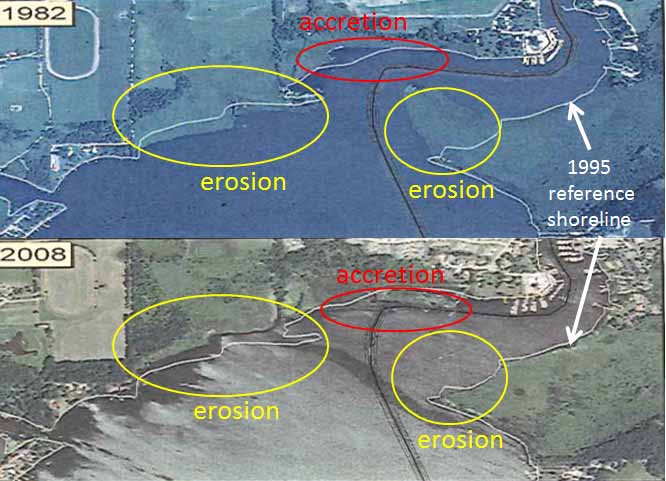Wisconsin’s bluffs, beaches, and harbor infrastructure are routinely impacted by a combination of erosion, coastal storms, and fluctuating water levels. We are taking a proactive Coastal Actions for Resilience and Economic Security (CARES) of Southeastern Wisconsin. Specifically, we will

Major challenge in coastal sustainability involves understanding the dynamics of the human-natural ecosystem. Humans are one essential component of coastal environments and as development increases, humans continue to alter the surrounding environment physically, and ecologically. These alterations interact with, and influence meteorological events, and long-term changes that affect the ecosystem as a whole. Scientific understanding is essential, and includes not only the physical sciences, but also a social understanding of how people and organizations act upon scientific evidence and decision-making. Coastal sustainability relies on integrated approach of interconnected areas of human and environmental processes. For example, sediment, an integral component of the coastal ecosystem, represents a public commodity that must be managed to provide for quality of life, natural resource protection, and economic sustainability. Specifically, nearshore sediment imbalances resulting from alteration of the natural environment threaten the viability of the public good and require management to restore the natural balance. We are interested in understanding coastal sediment processes with the purpose of helping guide environmental, regulatory, political, educational and process-related efforts anticipated when implementing regional based sediment management. Furthermore we devote coordinating beneficial reuse of sediment resources within a regional context and restore natural processes and simultaneously address sediment imbalances in the Great Lakes and inland lakes.
Nearshore circulation near coastal structures Sediment budget Beach and bluff evolution
Bluff recession along the coastline becomes an ever-increasing concern as high density facilities construction and development in the coastal zone, sustained high water levels, and episodic storm events combine to create severe erosional conditions. Coastal bluff erosion can be caused by two categories: subaerial and subaqueous processes. Subaerial bluff processes consist of bluff slope stability, bluff face erosion, and bluff toe erosion, occurring at different frequencies and magnitudes. Subaqueous processes include direct wave impact, horizontal retreat of bluff toe materials, and irreversible lakebed downcutting, a common coastal process along cohesive shorelines of the Great Lakes. For the short-term bluff recession, the most successful factor we have established is called Cumulative Wave Impact Height (CWIH) Index, which accounts for water level, wave runup, wind setup, and width of foreshore beach (Brown et al., 2005, Swenson et al. 2006). In the past decade, we have been examining nearshore lakebed downcutting, which is believed to control long-term bluff recession rates in Great Lakes. Studies show that depending on water levels and the thickness of overlying sand, downcutting can occur relatively continuously, compared to bluff recession and affects nearshore bathymetry. As a result waves can further erode intact bluff-toe material, creating a steeper bluff profile, promoting further slope failures, and yielding excessive bluff recession. While we have gained a tremendous amount of understanding the role of lakebed downcutting, obtaining reliable spatial measurements for quantifying spatial variation of bluff recession becomes challenging. Recently we have successfully developed the state-of-the-art geophysical method that combines acoustic-wave and electromagentic-wave based technique to effectively measure nearshore sublayer thickness (Lin et al., 2009, 2010). Through successive surveys, the changes of underlying glacial till bottom, i.e. the rate of lakebed lowering (downcutting), can thereby be determined. Ongoing research aims to examine/characterize/predict the evolution of high bluff in front of natural and newly built coastal structures in response to any dynamic subaerial and subaqueous change along Lake Superior and Michigan coastal areas in Wisconsin. The overall goal is to develop a balance between development and conservation with the purpose of optimizing the regional and long-term bluff mitigation strategies.



Spatial variation of bluff along the Great Lakes Combined acoustic & electromagnetic method Dynamic shoreline change in a river- lake system
Shoreline of small lakes plays an important role in overall lake ecosystem. For example shoreline provides habitat and food for a wide variety of flora, fauna, insects and micro-organisms. The interaction with surrounding terrestrial and aquatic systems affects the geochemical cycling and aging of these waters. Humans utilize shoreline of small lakes for a variety of recreational activities and enjoy their ecology and beauty. As a result any small change of shoreline in small lakes is critical. Many previous studies have identified that shoreline change of many small inland lakes can be caused by stream/river carried sediment plume, wave induced longshore sediment transport, or ice movement to grind and displace shoreline soil particles. Nevertheless little is known on the shoreline change of a river- lake system (e.g., Yahara river estuary) that can be affected by both seiches-generated reverse flow and wind waves during the open water season and ice-jam erosion during the winter season. Our ongoing research aims to employ a series of SediMeters to monitor the dynamic change of nearshore bottom sediment change caused by current-wave interactions. Successive low-altitude photos will be taken to track shoreline change. Cause and effects of shoreline change will be quantified and incorporated into a coupled hydrodynamic-sediment-shoreline evolution model for small lakes.
Sponsor :
Coastal
Resilience Grants, NOAA
Coastal Storms Program, NOAA
Fund for lake Michigan
Natural Resources Foundation of Wisconsin
University of Wisconsin Sea Grant Institute, NOAA
Wisconsin Coastal Management Program, NOAA
Wisconsin Department of Natural Resources
Wisconsin
Alumni
Research Foundation
Student Investigators:
Isak Fruchman (MS)
Graduated: Kevin Lin (PhD), Nick Jordan (MS), Bill Roznik (MS), Erica Hagen (MS), Mike Swenson (MS), Lisa Brown (MS)
Collaborators:
Professor, David Mickelson, GeoScience, UW-Madison
Professor Dante Fratta, Civil and Environmental Engineering, UW-Madison
Professor Bill Likos, Geological Engineering, UW-Madison
Professor Tuncer Edil, Civil and Environmental Engineering, UW-Madison
Mr. Gene Clark, Coastal Engineering Specialist, NOAA-UW Sea Grant Institute
Dr. Adam Bechle, Wisconsin Coastal Management Program
Mr. Todd Breiby, Wisconsin Coastal Management Program
Ms Kate Angle, Wisconsin Coastal Management Program
Opening
Publications:
- Jordan, N.B., Wu, C.H., Mickelson, D.M., Coastal Bluff
Evolution Adjacent to Shoreline Protection Structures on
the Western Lake Michigan Coast, to be submitted.
- Wu, C.H., Roznik, W.F., and, Jordan, N. B. Role of
longshore sediment transport on morphological changes
adjacent to coastal structures in Lake Michigan: to be
submitted.
- Hagen, E.J., Wu, C.H., and Fratta, D., Regional response to a bluff stabilization and enhancement project on Lake Michigan high bluffs, to be submitted.
- Hagen, E.J., Fratta, D., Wu, C.H., Applications of integrated geophysical techniques to monitor nearshore environment change in response to newly-built coastal structures in Lake Michigan, to be submitted.
- Lin, Y.T. and Wu, C.H., A field study of nearshore
environmental changes in response to newly-built coastal
structures in Lake Michigan, J. of Great Lakes
Research, 40, 102-114, 2014.
- Lin, Y.. T, Wu, C.H., Fratta, D., Kung, K.-J.S. Integrated acoustic and electromagnetic wave-based technique to estimate subbottom sediment properties in aquatic environment, Near Surface Geophysics, 8(3), 213-221, 2010.
- Lin, Y.T., Schuettpelz, C., Wu, C.H., and Fratta, D., A., combined acoustic and electromagnetic wave-based technique for bathymetry and subbottom profiling in shallow waters. Journal of Applied Geophysics, 68, 203-219, 2009.
- Swenson, M.J., Wu, C.H., Edil, T.B., Mickelson, D.M., Bluff recession rates and wave impact along the Wisconsin coast of Lake Superior, J. of Great Lakes Research, 32(3), 512-530, 2006.
- Brown, E.A., Wu, C.H., Mickelson, D.M., Edil T.B.,
Factors controlling rates of bluff recession at two
sites on Lake Michigan, J. of Great Lakes Research,
31(3), 306-321, 2005.